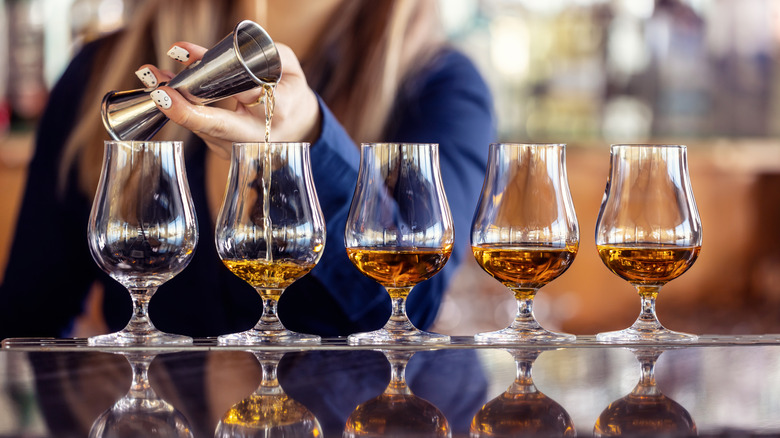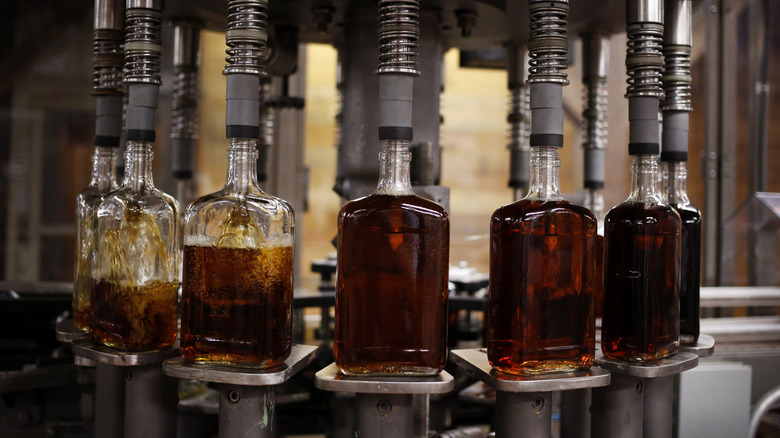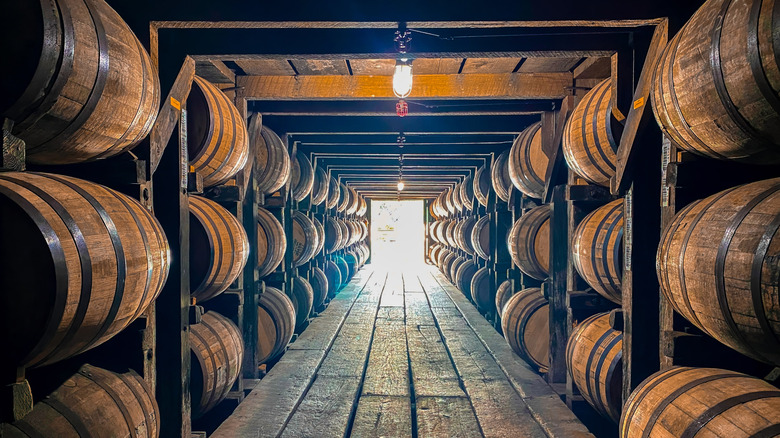Bourbon And Whiskey: What's The Big Difference Anyway?
If you've ever stood in the liquor aisle, staring at a wall of bottles, you may have found yourself wondering how to tell good whiskey from bad whiskey, or what actually separates bourbon from other whiskey. The labels look similar, the liquids look the same, and they're often shelved right next to each other. But there's actually a clear difference between bourbon and whiskey, and it comes down to where, how, and with what the products are made.
Bourbon is a specific type of American whiskey that follows stricter rules than your average bottle. The phrase "all bourbon is whiskey, but not all whiskey is bourbon" gets tossed around a lot, and it's true. Just like Champagne has to come from a certain place in France to be named as such, bourbon has to be made in the United States to earn the name. But even within the U.S., not just any old whiskey can be called bourbon. It also has to meet specific standards for ingredients and production methods laid out by federal regulations. Understanding those rules makes shopping for your next bottle a whole lot easier.
If it's bourbon, it's made in the U.S.
Whiskey can be made all over the world. Scotland has Scotch whisky, Ireland has Irish whiskey, and Canada has its own version, too. Bourbon, as mentioned previously, is a legally defined product that must be made in the United States. These rules aren't just suggestions, they're actually a part of U.S. law.
Now, bourbon whiskey doesn't have to come from Bourbon county, as many might think. That said, much of it does, because it was first created there, and bourbon is a large part of Kentucky's history. (Though there was also a time when North Carolina was the bourbon capital.) Kentucky's limestone-rich water is also said to help the distillation process, and the region's seasonal temperature shifts make it ideal for barrel aging. However, bourbon can technically be made anywhere in the U.S., so long as it also follows the guidelines regarding ingredients and production methods. So, if you're sipping something labeled "bourbon" that was made in Texas or Colorado, don't worry, it's still legit.
Bourbon also has rules for ingredients and aging
To understand the finer details of what defines bourbon, first we need to understand whiskey as whole. Whiskey is a liquor distilled from fermented grain mash that often includes corn, rye, barley, and/or wheat. But that's about it for whiskey's overall definition.
Bourbon has a more specific set of rules when it comes to ingredients and aging. All bourbon must, for example, have grain bill of at least 51% corn. The corn in bourbon is a big part of what gives the spirit its signature smoothness and slight sweetness. The rest of the mash can be made up of rye, barley, or wheat, which allows distilleries to tweak the flavors in their recipe.
Then there's the aging situation. All bourbon must be aged in brand new charred oak barrels. These fresh barrels give bourbon its rich amber color and contribute strong flavors like vanilla, caramel, and even a bit of spice. Other types of whiskey can be aged in used barrels, which often hold leftover flavors from previous spirits like sherry or port. This affects the taste in a big way, so using new oak barrels ensures a consistent flavor.
Bourbon is also controlled in terms of alcohol proof: It can be distilled to no more than 160 proof, must be aged at no more than 125 proof, and is bottled at no less than 80 proof. These tight regulations are why bourbon ends up with such a bold, distinct flavor compared to other types of whiskey.


